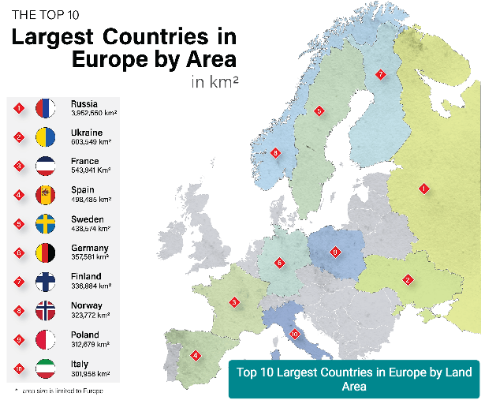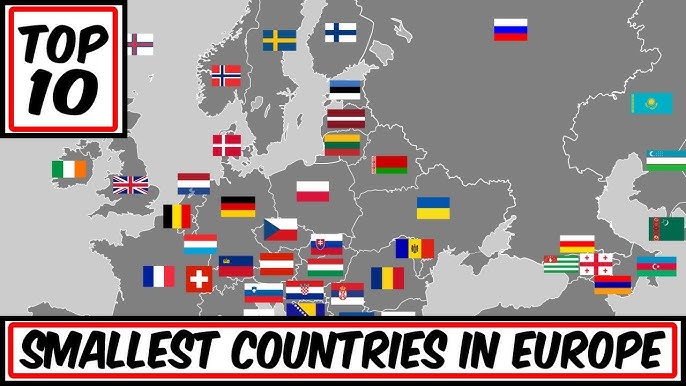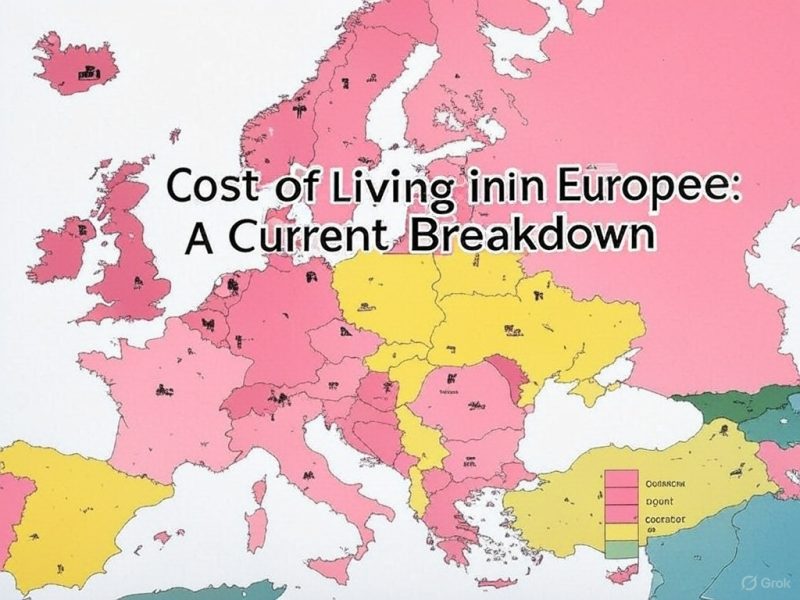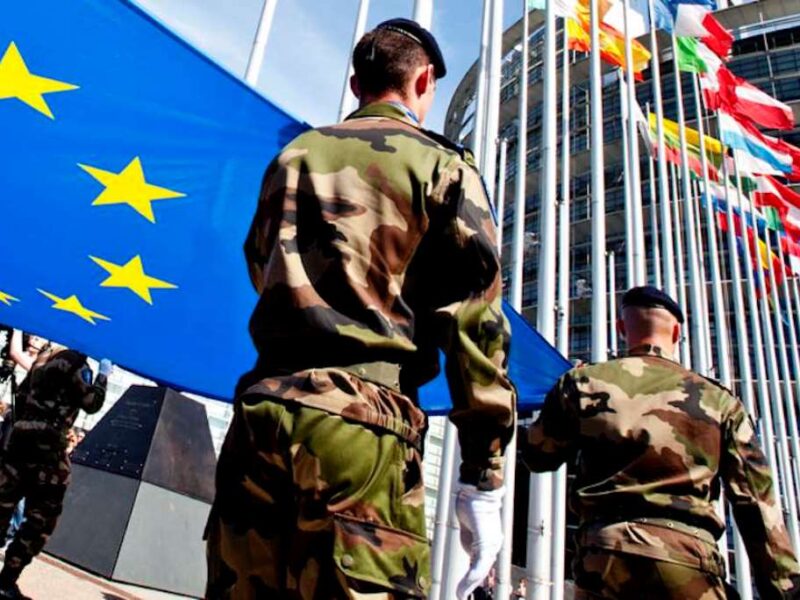Have you ever stared at a map of Europe and wondered just how massive some of these countries really are? Europe might be the second-smallest continent, but it’s packed with diversity—from icy tundras to sunny coastlines. If you’re searching for the largest countries in Europe or curious about Europe countries by size, you’ve landed in the right spot. Today, we’re diving into the top 10 largest countries in Europe by land area, chatting about what makes each one tick, and throwing in some mind-blowing facts along the way.
Why does this matter? Well, landmass isn’t just about bragging rights; it shapes everything from climate and culture to economy and wildlife. Whether you’re a traveler plotting your next adventure or just a trivia lover, understanding these biggest European countries by landmass gives you a fresh lens on the continent. Grab a coffee, and let’s rank ’em out—from the behemoth that dwarfs them all to the solid contenders rounding out the top 10. All areas are in square kilometers, sourced from reliable spots like World Population Review and Britannica for that up-to-date accuracy as of 2025.
1. Russia: The Unrivaled Titan of Europe
Clocking in at a staggering 3,995,200 square kilometers in its European territory alone, Russia isn’t just the largest country in Europe—it’s the biggest on the planet, period. [](grok_render_citation_card_json={“cardIds”:[“44f22a”]}) That’s right: if you squeezed the rest of Europe into one spot, Russia’s European chunk would still lap it several times over. Spanning from the Baltic Sea to the Ural Mountains, this transcontinental powerhouse blends Slavic heartlands with Siberian wilderness.
Picture this: endless birch forests, the frozen steppes where Cossacks once roamed, and cities like Moscow that pulse with history. Moscow, with its onion-domed cathedrals and the iconic Red Square, is a must-see. But don’t sleep on St. Petersburg—Peter the Great’s “window to the West” boasts canals that rival Venice. Fun fact: Russia’s European side holds about 75% of its 144 million people, making it denser than you’d think for such sprawl. Economically, it’s a energy giant, pumping out oil and gas that heats homes across the continent. Yet, challenges like the ongoing geopolitical tensions remind us that size comes with complexities. If you’re into vast landscapes, Russia’s the ultimate canvas.
2. Ukraine: The Breadbasket of Eastern Europe
Coming in strong at 603,550 square kilometers, Ukraine ranks as the second largest country in Europe. Nestled between Poland and Russia, it’s a land of golden wheat fields, the mighty Carpathian Mountains, and the black-soil steppes that earn it the nickname “Europe’s breadbasket.” Kyiv, the capital, is a gem with its golden-domed St. Sophia’s Cathedral, a UNESCO site that’s stood since the 11th century.
Despite recent conflicts, Ukraine’s resilience shines through its people and culture—think vibrant folk dances and hearty borscht. With 41 million residents, it’s a cultural crossroads, blending Orthodox traditions with modern vibes. Travel tip: Head to the Crimean Peninsula (pre-2014 vibes) for Black Sea beaches, or Lviv for architecture that whispers of Austrian and Polish influences. Ukraine’s size supports diverse ecosystems, from Danube Delta wetlands to Chernobyl’s eerie exclusion zone, a stark reminder of human impact.
3. France: The Hexagon of Elegance and Variety
France covers 551,695 square kilometers, making it the third largest country in Europe by land area. Ah, the “Hexagon”—named for its rough shape—stretches from the Pyrenees to the Alps, with coastlines on the Atlantic, Mediterranean, and English Channel. Paris? Iconic. But venture beyond the Eiffel Tower to Provence’s lavender fields or Normandy’s rugged cliffs, and you’ll see why France is a size queen in scenery.
Home to 68 million people, it’s a global trendsetter in food, fashion, and art. Bordeaux wines, Loire Valley chateaus, and the Riviera’s glamour define its charm. Economically, it’s Europe’s second-largest by GDP, fueled by tourism and aerospace. Fun twist: Overseas territories like French Guiana add exotic flair, but we’re sticking to the mainland here. If landmass means lifestyle, France delivers in spades.
4. Spain: Sunshine, Siestas, and Spectacular Diversity
At 505,990 square kilometers, Spain claims the fourth spot among largest European countries. From the snowy Sierra Nevada to Barcelona’s beaches, this Iberian powerhouse is a tapestry of regions—Catalonia’s fiery independence, Andalusia’s flamenco soul, and the Basque Country’s pintxos paradise. Madrid buzzes as the capital, but Seville’s Alcazar palace steals hearts.
With 47.8 million folks, Spain’s size supports olive groves that produce half the world’s supply and renewable energy pushes in wind-swept plains. History buffs, rejoice: Roman aqueducts in Segovia and Moorish Alhambra in Granada showcase layers of conquest. Post-pandemic, eco-tourism is booming—hike the Camino de Santiago across 800 kilometers of pilgrim paths. Spain’s landmass? It’s the secret to its endless reinvention.
5. Sweden: Nordic Serenity on a Grand Scale
Sweden spans 450,295 square kilometers, edging into the top five biggest countries in Europe by landmass. This Scandinavian stunner stretches from fjord-like archipelagos to the Arctic Circle, where the midnight sun dances for weeks. Stockholm, built on 14 islands, feels like a fairy tale with its Gamla Stan old town.
10.5 million Swedes embrace “lagom”—just the right amount—in a welfare state that’s envy of the world. Forests cover 70% of the land, home to moose and lingonberries, while the economy thrives on Volvo cars and Spotify streams. Don’t miss the Icehotel in Kiruna or ABBA’s museum. Sweden’s size means space for solitude, perfect for that introspective hike.
6. Norway: Fjords, Peaks, and Polar Frontiers
With 385,207 square kilometers (or more if you count Svalbard), Norway is the sixth largest country in Europe. Imagine sheer cliffs plunging into turquoise fjords, northern lights flickering over Lofoten Islands—that’s Norway. Oslo’s Viking Ship Museum nods to seafaring roots, but the real draw is the outdoors: 385,000 lakes and a coastline longer than Australia’s.
5.5 million Norwegians live high on oil wealth, funding everything from salmon farms to Nobel Prizes. Sustainability is king here—electric cars zip silently in Bergen. Fun fact: The Gulf Stream keeps it milder than you’d expect for such northern latitude. For adventurers, Norway’s landmass is a playground of trolls and trails.
7. Finland: Lakes, Saunas, and Santa’s Backyard
Finland’s 338,145 square kilometers land it at number seven in Europe land area rankings. Dubbed the “Land of a Thousand Lakes” (it’s actually 188,000), this Nordic haven is 75% forest, with Helsinki’s design district blending sauna culture and modern minimalism.
5.5 million Finns top happiness indexes, thanks to nature access and sisu—that gritty resilience. Lapland’s reindeer herds and Santa’s village in Rovaniemi add whimsy, while the economy hums with Nokia tech and forestry. Biodiversity thrives: Europe’s cleanest lakes host whooper swans. Finland’s size? Ideal for forest bathing without the crowds.
8. Germany: The Heartland Powerhouse
Germany measures 357,582 square kilometers, securing eighth among the top 10 largest countries in Europe. From Bavarian Alps to Baltic shores, it’s a federal mosaic of 16 states. Berlin’s Brandenburg Gate symbolizes reunification, but fairy-tale castles in the Rhine Valley steal the show.
84 million Germans drive Europe’s largest economy with precision engineering—think BMW and beer fests. History weighs heavy: Holocaust memorials in Berlin educate profoundly. Green initiatives shine in wind-powered Schleswig-Holstein. Size-wise, it’s compact yet mighty, proving efficiency over expanse.
9. Poland: Resilience in the Plains
At 312,685 square kilometers, Poland is the ninth largest European country by size. Flatlands meet the Tatra Mountains, with Warsaw’s reborn old town rising from WWII ashes. Krakow’s Wawel Castle whispers of kings past.
38 million Poles blend Catholic fervor with pierogi passion. It’s an agricultural force, exporting apples galore, and a tech hub in Wroclaw. Auschwitz’s solemnity contrasts Baltic beaches. Poland’s landmass fosters unity, from Solidarity’s shipyards to modern EU prowess.
10. Italy: Boot-Shaped Bounty
Rounding out at 301,340 square kilometers, Italy boots into the top 10 largest countries in Europe by landmass. The Alps cradle Venice’s canals, while Sicily’s volcanoes add drama. Rome’s Colosseum? Eternal.
59 million Italians savor la dolce vita—pasta in Tuscany, gelato in Naples. Fashion capitals Milan and Rome fuel luxury, alongside ancient ruins. Vesuvius looms over Pompeii, a frozen snapshot of 79 AD. Italy’s size packs history, hills, and harbors into one irresistible package.
Beyond the Borders: What Europe’s Size Tells Us
Wrapping up our tour of the top 10 largest countries in Europe, it’s clear land area influences everything. Russia’s dominance highlights transcontinental quirks, while compact giants like Germany show density’s power. Europe’s total 10.18 million square kilometers cradle 744 million souls, blending tiny Vatican with these behemoths.
Climate change nibbles at coasts, but these nations lead in green tech. Fun comparison: The top 10 cover over 80% of Europe’s land—talk about heavy hitters! Whether hiking Norway’s fjords or sipping espresso in Italy, these spaces invite exploration.
What’s your favorite big European spot? Drop a comment below—I’d love to hear. If this sparked your wanderlust, share it with a map-loving friend. Safe travels, and here’s to the giants that make Europe epic!






